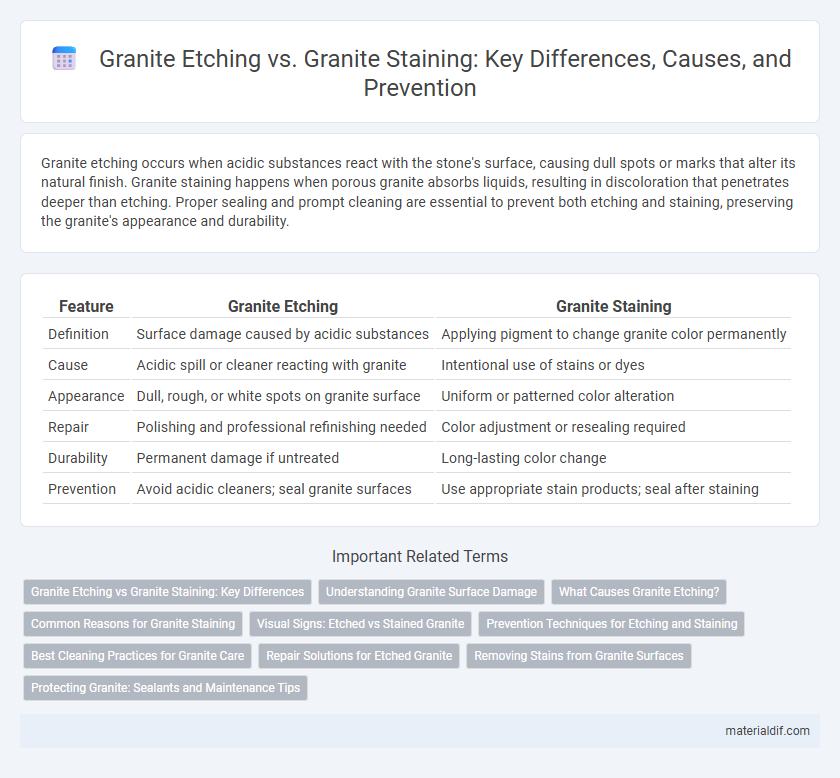Granite etching occurs when acidic substances react with the stone's surface, causing dull spots or marks that alter its natural finish. Granite staining happens when porous granite absorbs liquids, resulting in discoloration that penetrates deeper than etching. Proper sealing and prompt cleaning are essential to prevent both etching and staining, preserving the granite's appearance and durability.
Table of Comparison
| Feature | Granite Etching | Granite Staining |
|---|---|---|
| Definition | Surface damage caused by acidic substances | Applying pigment to change granite color permanently |
| Cause | Acidic spill or cleaner reacting with granite | Intentional use of stains or dyes |
| Appearance | Dull, rough, or white spots on granite surface | Uniform or patterned color alteration |
| Repair | Polishing and professional refinishing needed | Color adjustment or resealing required |
| Durability | Permanent damage if untreated | Long-lasting color change |
| Prevention | Avoid acidic cleaners; seal granite surfaces | Use appropriate stain products; seal after staining |
Granite Etching vs Granite Staining: Key Differences
Granite etching involves surface damage caused by acidic substances reacting with the stone, leading to dull spots or pits, whereas granite staining results from the absorption of oils or colored liquids that penetrate and discolor the stone. Etching primarily affects the finish and texture of granite without altering its inherent color, while staining changes the granite's appearance by embedding discolorants into the porous structure. Understanding these key differences is essential for selecting appropriate cleaning or restoration methods to maintain granite's durability and aesthetic appeal.
Understanding Granite Surface Damage
Granite etching refers to surface damage caused by acidic substances that dull and pit the polished finish, altering the stone's appearance without penetrating deeply. Granite staining occurs when porous areas absorb liquids or oils, leading to discoloration beneath the surface that can be harder to remove. Identifying whether the damage is etching or staining is crucial for selecting appropriate repair methods, as etching often requires polishing while staining may need specialized cleaning or sealing.
What Causes Granite Etching?
Granite etching is primarily caused by acidic substances such as lemon juice, vinegar, or harsh cleaners reacting with the stone's natural mineral composition, leading to dull spots or pits on the surface. Unlike staining, which results from absorbent materials penetrating porous areas, etching affects the granite's finish by chemically altering its surface. Understanding the difference is crucial for proper granite care and restoration.
Common Reasons for Granite Staining
Granite staining commonly occurs due to exposure to oils, acids, and water that penetrate the stone's porous surface, leading to discoloration and dull spots. Unlike etching, which results from chemical reactions causing surface dullness or marks, staining typically involves the absorption of external substances into the stone. Proper sealing and timely cleaning are essential to prevent and minimize granite staining caused by food, beverages, and harsh cleaners.
Visual Signs: Etched vs Stained Granite
Granite etching appears as dull, white marks that penetrate the surface, often caused by acidic substances reacting with the stone's calcite content. In contrast, granite staining manifests as discoloration that seeps into the pores, resulting in dark or yellowish spots due to oils, rust, or other contaminants. Visual identification relies on the opacity and texture; etched areas feel rough and matte, whereas stained areas remain smooth but visibly discolored.
Prevention Techniques for Etching and Staining
Granite etching often results from acidic substances reacting with the stone's surface, while staining occurs when porous areas absorb oils or liquids. Preventing etching involves promptly wiping spills, especially acidic foods like citrus and vinegar, and using pH-neutral cleaners designed for natural stone. To avoid staining, seal granite countertops regularly with high-quality sealers that fill pores and create a protective barrier against moisture and oils.
Best Cleaning Practices for Granite Care
Granite etching occurs when acidic substances react with the stone's surface, causing dull spots or marks, while granite staining results from porous granite absorbing oils, wine, or other liquids. Best cleaning practices for granite care include using pH-neutral granite cleaners, avoiding acidic or abrasive substances, and promptly wiping spills with a soft cloth to prevent etching and staining. Regular sealing of granite countertops enhances resistance to stains and helps maintain their natural luster and durability.
Repair Solutions for Etched Granite
Granite etching requires specialized repair solutions that involve polishing or honing to restore the surface's natural luster without compromising durability. Unlike granite staining, which penetrates the stone to alter its color permanently, etching damages the surface top layer and can be effectively treated with professional refinishing techniques. Proper repair of etched granite preserves the stone's integrity and extends the lifespan of countertops or flooring.
Removing Stains from Granite Surfaces
Granite etching involves light surface damage caused by acidic substances, which creates dull spots that can be polished out, while granite staining penetrates deeper into the stone, requiring specialized poultices or chemical treatments to remove embedded discolorations. Effective stain removal from granite surfaces depends on identifying the stain type--oil-based, organic, or metallic--to apply the correct solvent or poultice. Regular sealing of granite prevents staining by creating a protective barrier, ensuring easier maintenance and longevity of the stone's natural appearance.
Protecting Granite: Sealants and Maintenance Tips
Granite etching results from chemical reactions causing surface dullness, whereas granite staining involves pigment absorption leading to discoloration. Protecting granite requires applying high-quality sealants that penetrate pores, preventing stains and etching by creating a barrier against moisture and acids. Regular maintenance includes immediate cleaning of spills with a pH-neutral cleaner and periodic resealing every 1-3 years to preserve granite's durability and aesthetic appeal.
Granite Etching vs Granite Staining Infographic

 materialdif.com
materialdif.com